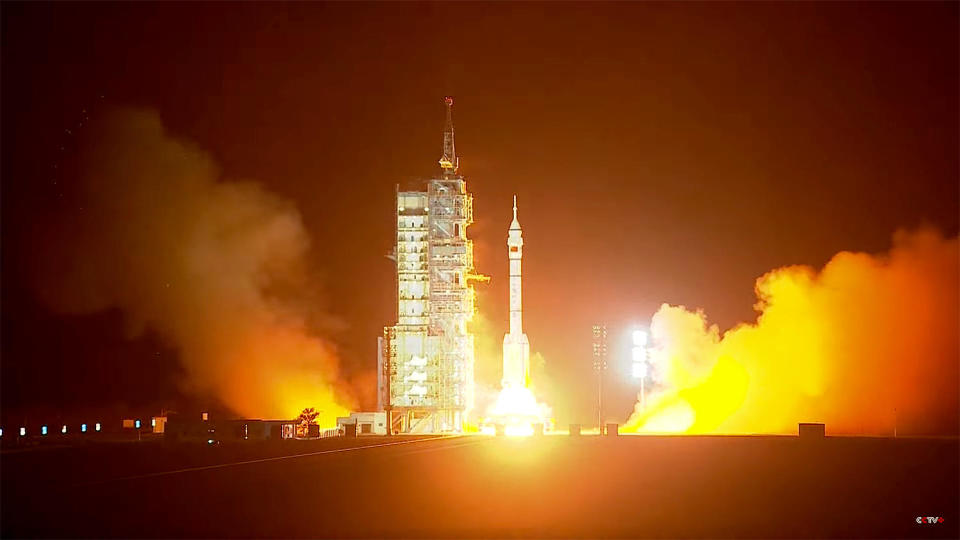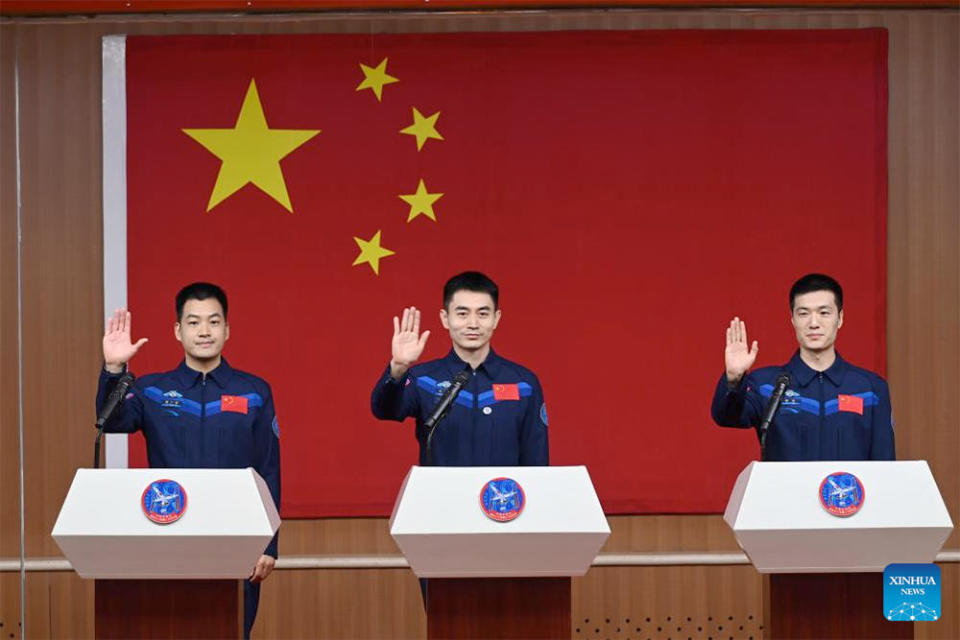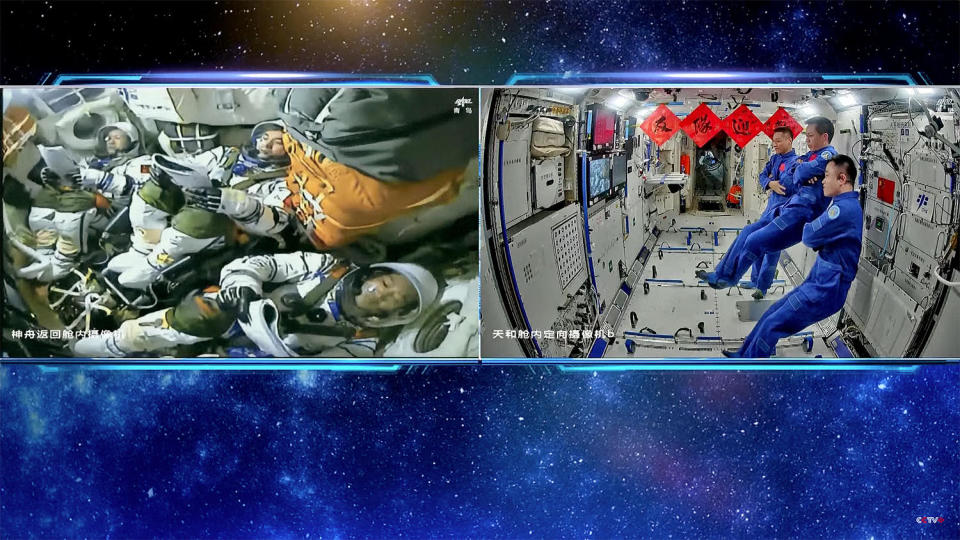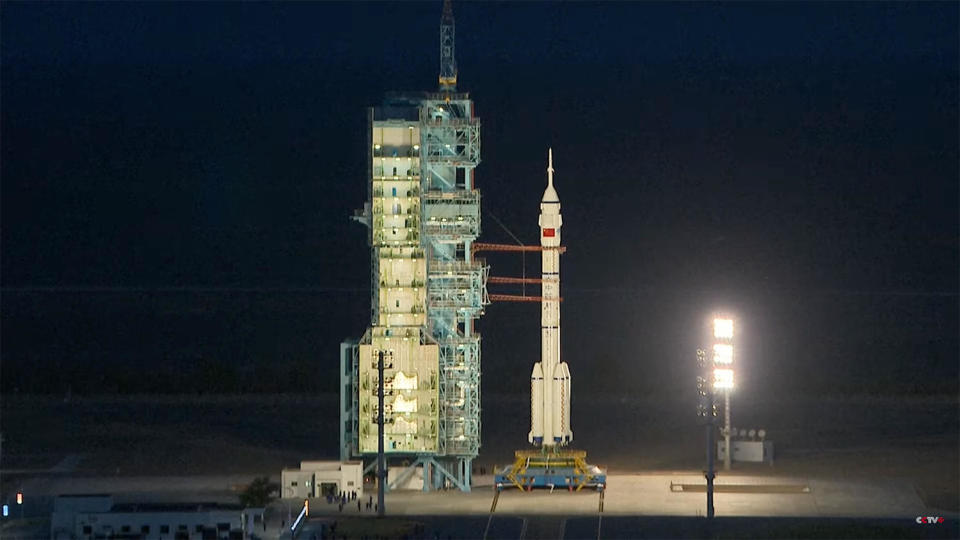Three Chinese taikonauts blasted off from the Jiuquan Satellite Launch Center in northwest China on Thursday and set off after the the Tiangong space station to replace three long-duration crew members who are closing out a six-month stay in space.
With veteran Ye Guangfu, 43, at the controls of the Shenzhou 18 spacecraft, flanked by rookies Li Cong, 34, and Li Guangsu, 36, the Long March 2F rocket roared to life at 8:59 a.m. EDT (8:59 p.m. Beijing time) and smoothly climbed away on a southwesterly trajectory matching the station’s orbit.

The flight plan called for Ye and his crewmates to monitor an automated rendezvous and docking at Tiangong station six-and-a-half hours after liftoff, joining Shenzhou-17 commander Tang Hongbo, Tang Shengjie and Jiang Xinlin aboard the orbital outpost.
“My two crew members and I, as well as the entire space mission team, are fully prepared and confident (in our ability) to complete this space flight mission,” Ye said in translated remarks during a news conference Wednesday.
Tang and his crewmates plan to depart and return to Earth with landing in the Inner Mongolia Autonomous Region on April 30, closing out a six-month stay in orbit that began with launch on Oct. 25.
The Shenzhou 18 flight is China’s seventh piloted mission to the space station and its fifth since around-the-clock staffing began in June 2022. The launching was carried live on Chinese television, providing spectacular shots of the rocket’s climb to space and interior views of the taikonauts as they monitored cockpit displays.
Ye is the only space veteran on the crew, completing a 182-day tour of duty in 2021-22 as part of the Shenzhou 13 mission. Li Cong and Li Guangsu are rookies making their first flight.
As a first-time flyer, Li Guangsu said he was looking forward to traveling 7.9 meters per second — roughly 17,500 mph — and “cannot wait” to experience weightlessness.

“There are no wings, but I still can fly!” he said at the traditional pre-flight news conference. “What a great experience for me. I also would like to take this opportunity to see the blue planet, to have a good look at the marvelous landscape of our motherland.”
During their stay in space, Ye and company will carry out a full slate of more than 90 scientific research projects along with two to three spacewalks to install external experiments, micrometeoroid shielding and other equipment.
Lin Xiqiang, deputy director of the China Manned Space Agency, said the crew also will participate in ongoing science education outreach and unload the Tianzhou-8 cargo ship before their Shenzhou 19 replacements arrive in October.
The Chinese space station is made up of three large modules connected in a T-shaped configuration. The Tianhe core module, launched in April 2021, is the centerpiece of the complex, providing crew quarters, life support systems, communications, spacecraft controls, an airlock and multiple docking ports.
Two other large modules — Wentian and Mengtian — were attached to Tianhe in 2022. The station has a mass of about 100 tons.
The 450-ton International Space Station is made up of more than a dozen pressurized modules provided by the United States, Russia, the European Space Agency and Japan. Construction began in 1998 and the lab has been permanently staffed by rotating astronaut-cosmonaut crews since 2000.

The Tiangong station has been permanently staffed since June 2022 with the arrival of the Shenzhou 14 crew. While smaller than the ISS, the Chinese lab is newer and equipped with state-of-the-art equipment, computers and instrumentation.
NASA and its partners plan to retire the ISS in 2030, remotely driving it to a destructive re-entry in the atmosphere above the south Pacific Ocean, well away from shipping lanes and populated areas. That will leave Tiangong as the only government-operated space station in low-Earth orbit.
NASA is counting on commercial space stations operated by private companies to provide research opportunities in Earth orbit in the 2030s while the U.S. agency pursues a return to the moon later this decade with the agency’s Artemis program.
China plans to launch its own taikonauts to the moon starting in 2030, fueling what NASA Administrator Bill Nelson calls a new superpower space race.
“It is a fact: We’re in a space race,” he told Politico in an interview published last year. “And it is true that we better watch out that they don’t get to a place on the moon under the guise of scientific research. And it is not beyond the realm of possibility that they say, ‘keep out, we’re here, this is our territory.'”
The CGTN news agency, quoting Lin, said the Long March-10 moon rocket, the Mengzhou (Dream Vessel) crew transport spacecraft and the Lanyue (Embracing the Moon) lunar lander have completed design reviews and prototypes are currently being tested.
NASA plans its first piloted Artemis mission late next year, launching three NASA astronauts and a Canadian flyer on a looping voyage around the moon and back to test the agency’s Orion crew transport ship.

If all goes well, NASA plans to land astronauts near the moon’s south pole in the 2026-27 timeframe. But that will depend on SpaceX perfecting its Starship moon lander and Super Heavy booster.
China is in the process of selecting a fourth batch of taikonauts that Lin said will participate in space station activities as well as upcoming moon missions.
He repeated comments he made before the Shenzhou 17 launch, saying China, like the United States and its ISS partners, plans to begin launch fliers from other nations, including space tourists.
“We will accelerate the research and promotion of the participation of foreign astronauts and space tourists in flights with China’s space station,” he said in translated remarks published by The Washington Post. “We definitely expect to see astronauts of different identities on China’s space station.”
U.S. Catholics and their relationship to the church
Pope Francis says “negotiated peace is better than a war without end”
Harvey Weinstein’s rape conviction overturned by New York appeals court
